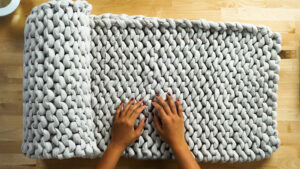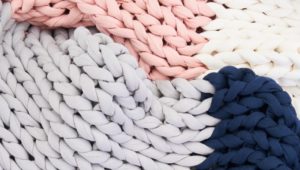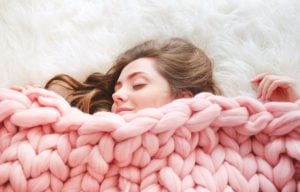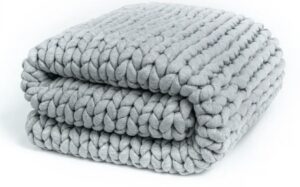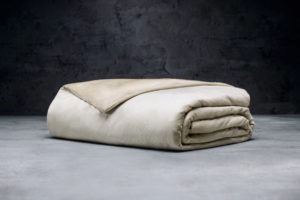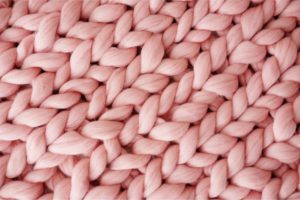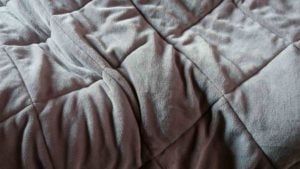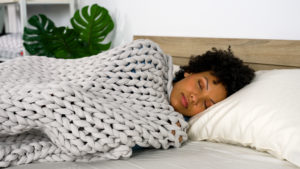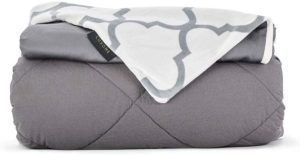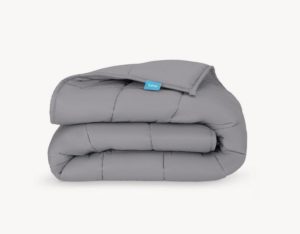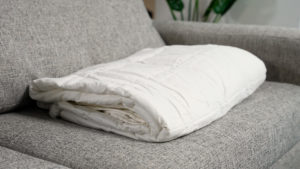Are Weighted Blankets Hot?
Because they’re heavier and often use dense materials that trap heat, weighted blankets be warmer than regular blankets. However, not all weighted blankets are hot. Cooler options use breathable fabrics like cotton or bamboo and temperature-regulating fillers like glass beads. If you tend to sleep hot, choosing a weighted blanket designed for airflow can provide calming pressure without overheating.
Weighted blankets can feel like a cozy hug, but sometimes that hug might make you a bit too hot. While many people love the benefits of weighted blankets, like soothing pressure and potential to ease stress and anxiety; others worry they might trap too much heat. The truth is, not all weighted blankets are created equal. Whether a blanket sleeps warm or cool depends on the materials and construction used, with some designed to retain warmth and others built to keep you comfortably cool.
What Affects the Heat Retention of a Weighted Blanket
Just like regular cooling blankets, the warmth of a weighted blanket depends on the materials and construction. Some are built to insulate, while others are designed to breathe.
Cover Fabric
The outer fabric of a weighted blanket plays a big role in how warm—or cool—it feels. Materials like flannel, fleece, and wool tend to trap heat and feel cozy, making them ideal for colder climates but potentially too warm for hot sleepers. On the other hand, breathable fabrics like cotton, bamboo, rayon, and Tencel are more lightweight and moisture-wicking, helping to dissipate heat and keep you cooler throughout the night.
Fill Material
What’s inside the blanket matters just as much as the cover. Weighted blankets are typically filled with micro glass beads, plastic pellets, or natural grains like microbeads or rice. Micro glass beads tend to be more breathable and less bulky, which can make the blanket feel cooler. Plastic pellets and natural grain fills are generally more insulating, which may contribute to a warmer sleeping experience. Some cooling weighted blankets also include fill designed to draw heat away from the body or promote airflow between layers.
Construction
Weighted blankets generally come in two styles: knitted or duvet-style. Knitted designs use thick yarn to create weight while leaving open weaves that promote airflow, especially when made with breathable, natural materials like cotton. Duvet-style blankets are more traditional and use glass beads, plastic pellets, or similar fill encased in a fabric shell—often with added batting for a smoother feel. The shell may be cotton, polyester, or a blend, and some models come with removable, machine-washable covers for easier cleaning.
Weight
Heavier blankets naturally retain more body heat, since their increased density limits airflow. While weight is crucial for delivering the deep pressure stimulation that makes weighted blankets effective, it can also add to the blanket’s warmth. People who sleep hot or live in warmer climates might prefer a lighter weight within the recommended range—usually about 7% to 10% of their body weight—to get the calming benefits without the extra heat.
| Warmer Weighted Blankets | Cooler Weighted Blankets | |
|---|---|---|
| Cover Fabric | Fleece Flannel Wool | Bamboo Rayon Cotton Tencel |
| Fill Material | Plastic pellets Natural grains (like rice or millet) Microbeads | Glass beads Steel beads Open-weave fiberfill |
| Construction | Duvet-style | Knitted |
| Weight | 10% to 12% of your body weight | 7% to 10% of your body weight |
How to Choose a Weighted Blanket for Hot Sleepers
If you tend to overheat at night but still want the calming benefits of a weighted blanket, you’re not out of luck. The best weighted blankets for hot sleepers are specifically designed with breathable materials and cooling features to help with temperature regulation and minimize heat retention.
Knitted weighted blankets are a top choice for hot sleepers thanks to their open-weave design, which allows for excellent airflow. Many are made with breathable yarns like cotton or bamboo-derived fabrics that help wick away moisture and keep you cool throughout the night.
Cooling duvet-style weighted blankets typically use glass beads as fill, which hold less heat than plastic alternatives. They may also incorporate lightweight batting and breathable cover materials like cotton, Tencel, or bamboo viscose. These fabrics not only promote airflow but also help manage sweat and humidity.
Ultimately, the best option for hot sleepers combines breathable construction with moisture-wicking fabrics, so you can enjoy the calming hug of your blanket without waking up in a sweat.
How to Sleep Cool With a Weighted Blanket
Weighted blankets can feel cozy, but if you’re a hot sleeper, they might also make you feel overheated. Fortunately, there are easy ways to stay cool without giving up the benefits of deep pressure stimulation.
- Skip extra layers: Try using your weighted blanket on its own and ditch the top sheet or comforter to cut down on trapped heat.
- Adjust the room temperature: Lowering your thermostat a few degrees can help balance out the warmth of your blanket.
- Use a fan or open a window: Increasing airflow in your bedroom can make a big difference in how comfortable you feel.
- Try a summer-weight version: Many brands now offer cooling or lightweight versions of their weighted blankets for year-round use.
- Consider your sleepwear: Breathable, moisture-wicking pajamas made from cotton or bamboo can help you stay cool and dry.
- Add a cooling mattress pad or pillow: Your sleep surface can influence how hot or cool you feel overall. Cooling mattresses and accessories can provide extra relief.
Experiment with a few of these tweaks to find the setup that help improve sleep quality and stay comfortably cool.
Frequently Asked Questions
What’s the ideal sleep temperature?
Most experts recommend a bedroom temperature between 65 and 68 degrees Fahrenheit for sleeping. Using some sort of blanket or covers in a cool environment is also recommended. However, the most comfortable sleep temperature is somewhat subjective.
The right temperature creates a calm atmosphere to fall asleep and stay asleep. Too high a temperature can contribute to poor sleep, including waking up during the night. A high temperature can also lead to decreased slow-wave sleep, otherwise known as deep sleep.
Are weighted blankets good for night sweats?
Some weighted blankets are made with breathable fabrics and cooling fills that can help reduce overheating, but others may trap heat and make night sweats worse. If you’re prone to night sweats, look for a weighted blanket labeled as cooling or made with moisture-wicking, breathable materials.
When should you not use a weighted blanket?
Avoid using a weighted blanket if you have certain medical conditions like sleep apnea, respiratory issues, or mobility limitations without first consulting a healthcare provider. They’re also not recommended for young children under age 2 due to safety concerns.

Still have questions? Ask our community!
Join our Sleep Care Community — a trusted hub of sleep health professionals, product specialists, and people just like you. Whether you need expert sleep advice for your insomnia or you’re searching for the perfect mattress, we’ve got you covered. Get personalized guidance from the experts who know sleep best.


